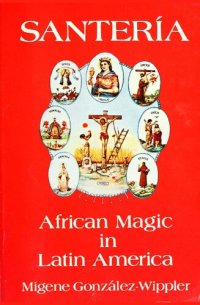
Ebook: Santería: African Magic in Latin America
Author: Migene Gonzalez-Wippler
- Genre: Other Social Sciences // Ethnography
- Tags: santeria, orisha, yoruba, santeraafrican00gonz
- Year: 1990
- Publisher: Original Publications
- City: Bronx, New York
- Edition: 6
- Language: English
- pdf
Santería, like other ancient religions, is passed on through oral tradition from one generation to the next. It contains not only the history of a people determined to survive against overwhelming odds, but also their ritual behavior, forcibly inscribed in their consciousness through constant suffering and persecution.
Growing academic interest in the social and psychological benefits to be gained through the practice of Santería has resulted in many research projects, mostly sponsored by the departments of psychiatry of many medical schools. Present research is mostly directed to better understanding the practice of Santeria’s effects on its believers and how it helps them cope with problems of adjustment. Increasing numbers of North Americans, both black and white are becoming adherents of Santeria and are also the subject of much academic interest and speculation.
Santeria emerged as a struggle for cultural and ideological survival between the enslaved West African Yoruba people and the Roman Catholic Church in union with the Spanish Empire. Slaves transformed the enforced worship of the Catholic saints into the veiled worship of their spirit ancestors. For centuries, the resulting magico-religious system remained an enigma to the Christian world. Only recently have some of Santeria’s traditional practices come to light.
It should be noted that Santeria is not confined to the Caribbean and to South America. As a result of the migration of large amounts of Caribbean people, it is now practiced in the great cities of the United States and Canada, inevitably winning converts among North Americans of varied ethnic backgrounds. These cross-currents of migration have kindled new interest in America’s African and Hispanic cultural heritage.
Growing academic interest in the social and psychological benefits to be gained through the practice of Santería has resulted in many research projects, mostly sponsored by the departments of psychiatry of many medical schools. Present research is mostly directed to better understanding the practice of Santeria’s effects on its believers and how it helps them cope with problems of adjustment. Increasing numbers of North Americans, both black and white are becoming adherents of Santeria and are also the subject of much academic interest and speculation.
Santeria emerged as a struggle for cultural and ideological survival between the enslaved West African Yoruba people and the Roman Catholic Church in union with the Spanish Empire. Slaves transformed the enforced worship of the Catholic saints into the veiled worship of their spirit ancestors. For centuries, the resulting magico-religious system remained an enigma to the Christian world. Only recently have some of Santeria’s traditional practices come to light.
It should be noted that Santeria is not confined to the Caribbean and to South America. As a result of the migration of large amounts of Caribbean people, it is now practiced in the great cities of the United States and Canada, inevitably winning converts among North Americans of varied ethnic backgrounds. These cross-currents of migration have kindled new interest in America’s African and Hispanic cultural heritage.
Download the book Santería: African Magic in Latin America for free or read online
Continue reading on any device:

Last viewed books
Related books
{related-news}
Comments (0)